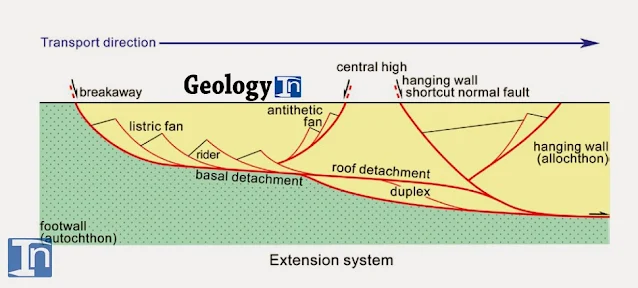Divergent Plate Boundary: The Extension Systems
Divergent plate boundaries are zones where plates split into two or more smaller plates that move apart and the dominant stress field is extension. To accommodate the separation, dominantly normal faults and even open fissures form where crustal rocks undergo stretching, rupture and lengthening. Because the lithosphere is thinned, there is upwelling of the mantle below the necked crust.
Decompression of the mantle results in partial melting and basaltic magma produced is injected into the fissures or extruded as fissure eruptions. Basaltic magmatism at the axis of a ridge creates new oceanic lithosphere as plates diverge from one another; this process is called seafloor spreading. Divergent plate boundaries are some of the most active volcanic areas on the Earth.
This process is so important that more than half of the earth’s surface has been created by volcanic activity along divergent boundaries during the past 200 Ma.
Bulk lithospheric rheologies control the development of large-scale extensional structures that can be classified as follows:
Continental lithosphere
| ||
Narrow rift systems
|
East African rift system, Rhine Graben, North Sea
| |
Wide extensional systems
|
Basin and Range
| |
Passive margins
|
Bay of Biscay
| |
Oceanic lithosphere
| ||
Young oceanic basins
|
Gulf of Suez, Read Sea
| |
Mid ocean ridges
|
Mid-Atlantic ridge
| |
Back-arc basins
|
Philippines
| |
In terms of plate tectonics, the extension systems are associated with:
- - Constructive plate boundaries (oceanic and continental rift zones)
- - Destructive boundaries (back-arc spreading, marginal basins)
- - Intra-continental regions (rifts and extensional basins).
Smaller-scale extensional settings include gravitational collapse of thickened crusts and continental margins, and local extension due to magmatic and salt domes.
Read also: Divergent Boundary: Definition, Features, Examples
The Terminology of Extensional Tectonics
Accommodation zones
Accommodation zones Normal fault systems are not continuous along the length of a rift. Rather, rifts are divided intosegments, whose axes may be offset from one another. Further, the faults of one segment may dip in the opposite direction to the faults of another segment. An accommodation zone is the region of complex structure that links the ends of two rift segments. Accommodation zones typically include strike-slip faults.
Active Margin
Active margin A continental margin that coincides with either a strike-slip or convergent plate boundary, and thus is seismically active.
Aulacogen is An unsuccessful rift that cuts across a continental margin at a high angle to the margin. Typically, aulacogens transect the grain of an orogen that borders the margin. Aulacogens may represent failed arms of three-armed rifts, or they may simply be older rifts (formed long before the development of the continental margin, during an earlier episode of rifting at a different orientation) that were cut off when the margin formed .
The Terminology of Convergent plat Boundary
Accretionary prism A wedge of deformed sediment, and locally deformed basalt, that forms along the edge of the overriding slab; the material of the accretionary prism consists of pelagic sediment and oceanic basalt scraped off the downgoing plate, as well as sediment that has collected in the trench.
Arc-trench gap The horizontal distance between the axis of the volcanic arc and the axis of the trench.
Backarc basin A narrow ocean basin located between an island arc and a continental margin.
Backarc region A general term for the region that is on the opposite side of the volcanic arc from the trench.
Continental arc A volcanic arc that has been built on continental crust.
Allochthon The thrust sheet above a detachment is the allochthon (meaning that it is composed of allochthonous rock; i.e., rock that has moved substantially from its place of origin).
Autochthon The footwall below a detachment is the autochthon; it is composed of autochthonous rock, or rock that is still in its place of origin.
Contractional fault A contractional fault is one whose displacement results in shortening of the layers that the fault cuts, regardless of the orientation of the fault with respect to horizontal.
Décollement The French word for detachment.



%20(1).webp)






